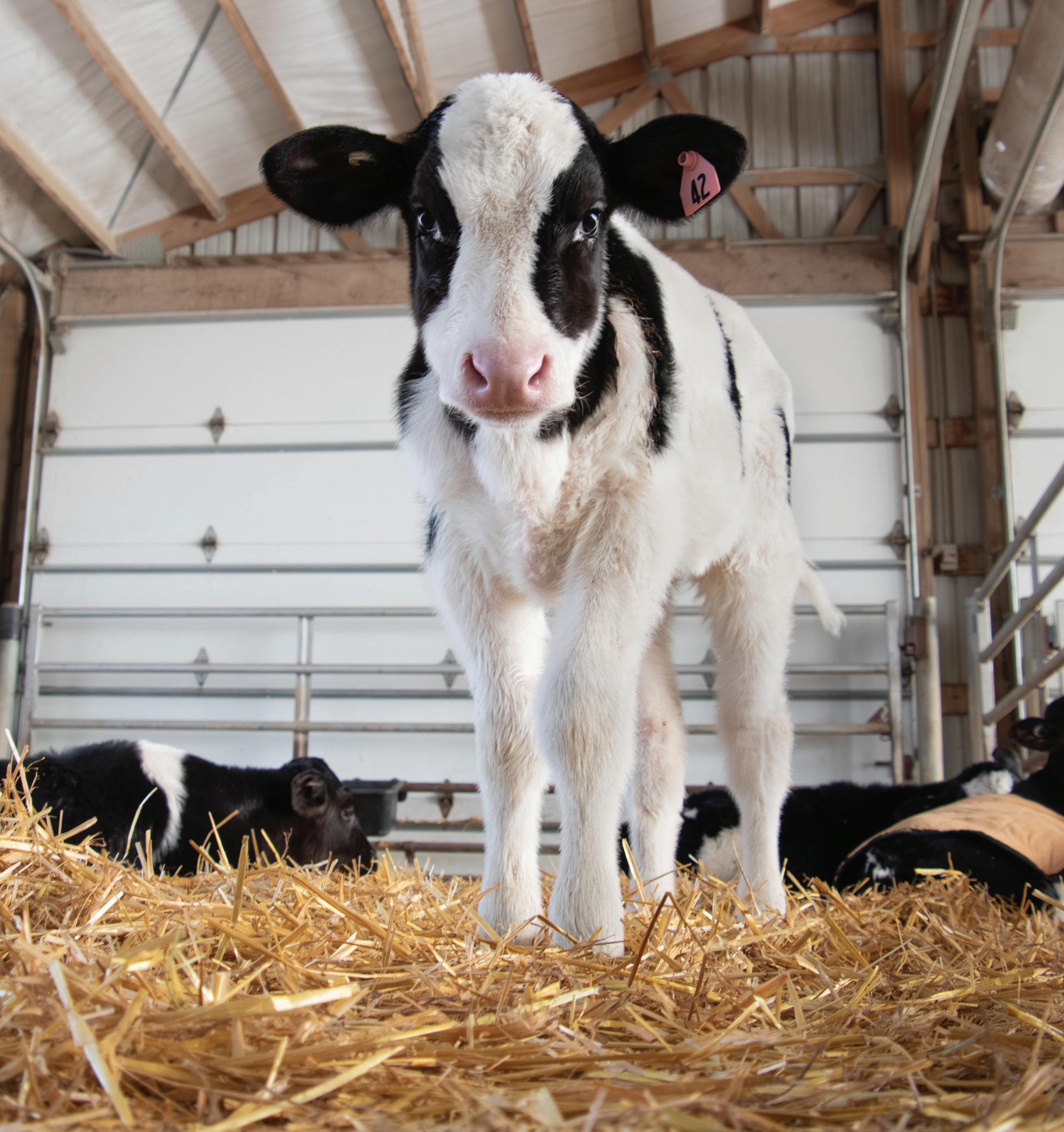
SPRING 2024 6 u DON’T TAKE CULL RATE AT FACE VALUE 7 u NET HERD REPLACEMENT COST 8 u TIME IS MONEY AT FORESIGHT FARMS 10 u NEW STANDARDS FOR COLOSTRUM 12 u BEEF ON DAIRY WISH LIST 14 u COWMANAGER TRANSITION ALERTS
SELECTIONS
 David C. Thorbahn, President and C.E.O., Select Sires Inc.
David C. Thorbahn, President and C.E.O., Select Sires Inc.
“My hope for the future of SMS is that we can continue to support our customers around the world in their pursuit of building better cows,” Brian Coyne, manager of applied genetic strategies, Select Sires Inc.
Brian hit the nail on the head in a recent interview to celebrate the 50th anniversary of Select Sires’ Select Mating Service® (SMS®) program. What was once done with pencil and paper has evolved to a complete, computerized mating program. Among the updates, iterations and innovations, one thing has remained the same – the people. The computer algorithms and handheld devices are important parts of the program, but the people providing the consultative service continue to be what sets Select Sires apart.
Whether we are talking about top sires, emerging genetic research or tools like SMS, our people are the driving force of change and herd improvement. The SMS program supports our core mission at Select Sires Inc. Genetic and reproductive consultation is how we support our customers around the world. Programs such as SMS and Select Reproductive Solutions® (SRS®) have been designed to manage and analyze dairy herd data. Today, each individual dairy generates a ton of data, and our consultants are trained to leverage these programs, help make sense of that data and create a customized plan tailored to meet your goals.
To achieve these goals, you might have to troubleshoot certain challenges within the herd. This edition of Selections breaks down some of the most common on-farm metrics to better understand the variables and factors. Once you understand each metric, you can put them to work to make herd improvements.
We asked Select Sires consultants to share on-farm experiences with many of these common metrics, as well as some unique ones. You might overlook culling and pregnancy rate thinking you have a good handle on those metrics or that they are simple and standard measurements, but I encourage you to take a second and third look at your herd’s data to uncover opportunities. Lean on your Select Sires consultants to look over this data and your current protocols to better understand your situation.
Just as the SMS program has evolved over 50 years, our consultative teams have evolved to provide the services best suited for your herd. Lon Peters managed the SMS program from 1992 to 2019 and he often compared the program to a GPS navigation system. “A GPS device is a small piece of technology that takes information about where I want to be and gives me clear, precise directions to get me to my destination,” said Peters. “The GPS device mirrors the goal of the SMS program by saving time for our dairy producers and setting a clear direction.”
Let Select Sires be your GPS device to lead you in the most profitable genetic direction. Share your goals and allow our reproductive and genetic consultants to guide your dairy to immense success! u
CAPTURE GENETIC TRENDS
like never before!
Gain access to our most elite genetics and maximize your herd’s genetic gain by joining the NxGEN program! Our current lineup provides chart-topping sires with diverse pedigrees and well-balanced profiles.
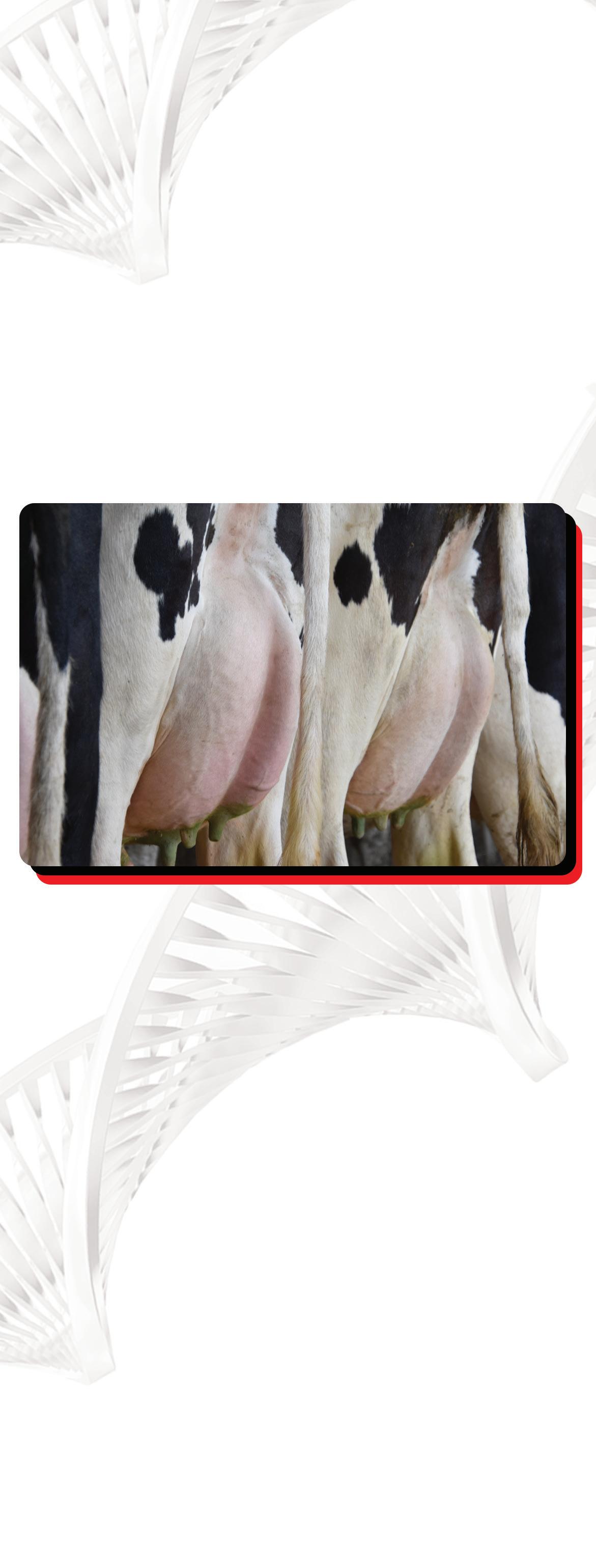
“ NxGEN allows us to have the first bite of the apple on early release bulls. Seeing the NxGEN calves when they hit the ground makes me feel like we have hit the lottery. Using these early release bulls and seeing their daughters develop, get pregnant with ease and enter the milking string – it is quite impressive.”
Justin Stewart Arizona Dairy Co., Mesa, AZ
u 1 u 2
CONSULTANTS CREATE OPPORTUNITIES
CURRENT
AVERAGES +190 CFP +1,262 HHP$® +1,246 DWP$® +3181 GTPI® +1,213 CM$
LINEUP
Daughters of previous NxGEN sire 14HO15223 CONWAY, Summit Farms, LLC, Plymouth, WI
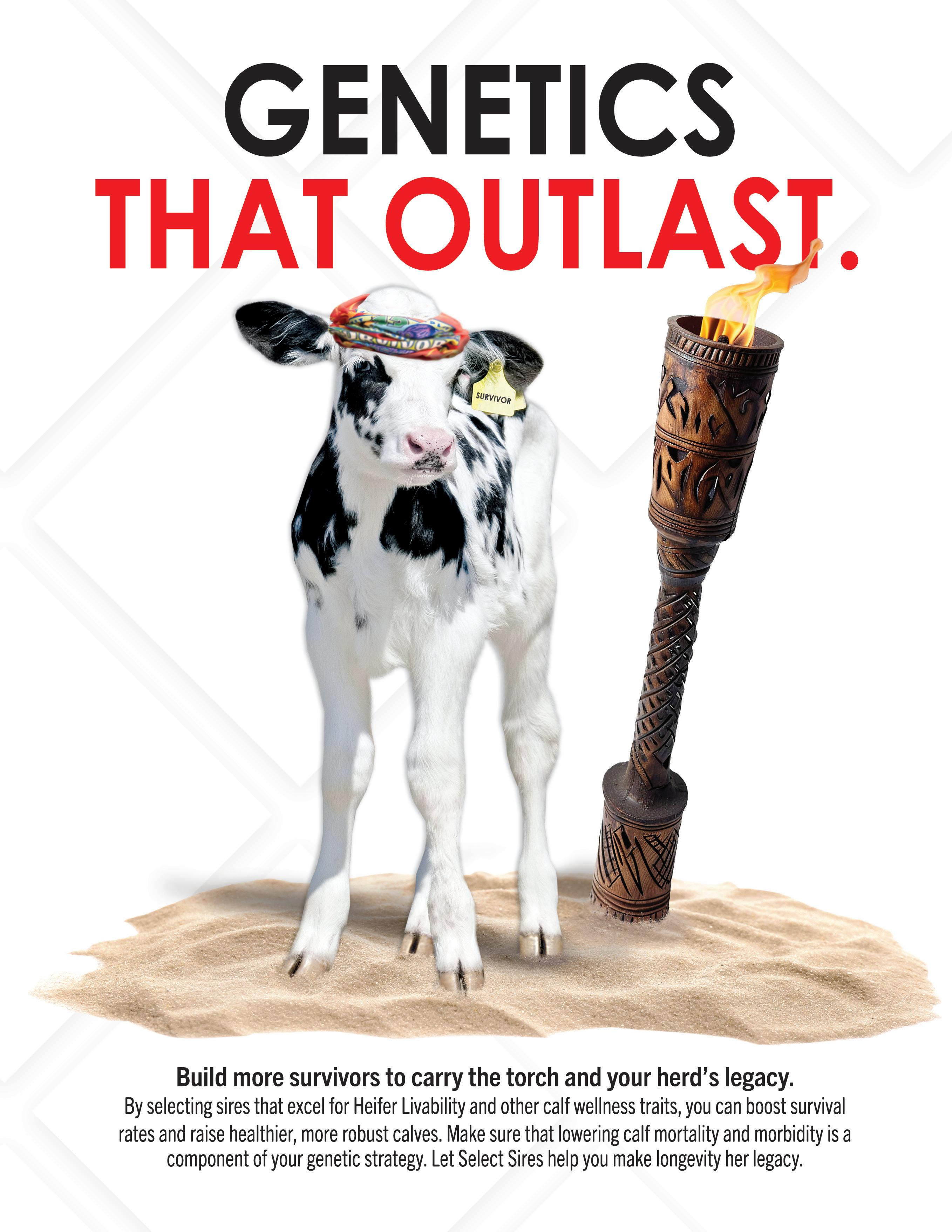

MAKING SENSE OF THE METRICS
“You can’t manage what you can’t measure.”
There is no shortage of data on a dairy farm – animal monitoring systems, genomic information, milk test results and manual record keeping are just a few sources of data. Consultants and advisors can help you make sense of your data by creating metrics and comparing to industry benchmarks. Analysis and application of your dairy’s metrics reveal opportunities and challenges relating to any aspect of the business, including cow health, young stock protocols, genetics, nutrition, management and much more. We’ve compiled some of the most standard and unique metrics that correlate to and influence profitability.
*Quote attributed to the late business consultant and educator, Peter Drucker.
u
4
METRIC: CULL RATE
Are you keeping track of involuntary versus voluntary culls? What are the root causes of your involuntary culls? How accurate is your record keeping? Cull rate can be easily swayed by misinformation or misinterpreted information, but it is still a critical metric that feeds into herd profitability. Kelly Sporer, Ph.D., breaks down the intricacies of cull rate on page 6.
METRIC: NET HERD REPLACEMENT COSTS (NHRC)
In a joint study by Zoetis and Compeer Financial, NHRC accounted for a $375 per cow per year difference between the top third most profitable herds and the bottom third least profitable herds. Emily MiddletonGyomory illustrates the importance of NHRC on page 7 and offers an opportunity for farmers to calculate the NHRC of their herds.
Metric: COLOSTRUM IgG
Data analysis and metrics shouldn’t be reserved for your lactating herd – leverage your resources to make the best decisions for young stock. Testing maternal colostrum is incredibly important to get your calves off to the right start. On pages 10 and 11, David Cook, Ph.D., shares the new standards for passive immunity and solutions to ensure high-quality colostrum.

METRIC: PREGNANCY RATE
Possibly one of the first metrics you learn about and begin to fine-tune when managing a dairy, pregnancy rate is a priority for all herds. However, it’s common for herds to plateau with their pregnancy rate and lose sight of the immense influence it has on all other areas of the farm. Learn more about Foresight Farms’ reproductive analysis and improvement on pages 8 and 9.
Metric: HOSPITAL PEN MANAGEMENT
While we don’t like seeing cows in the hospital pen, it does offer a lot of information about genetics, nutrition, management and more. Jordan Siemers shares six unique metrics relating to sick or injured cows and how this information can influence the decision-making process. Review his six hospital pen metrics on page 13.
u 5
DON’T TAKE CULL RATE AT FACE VALUE
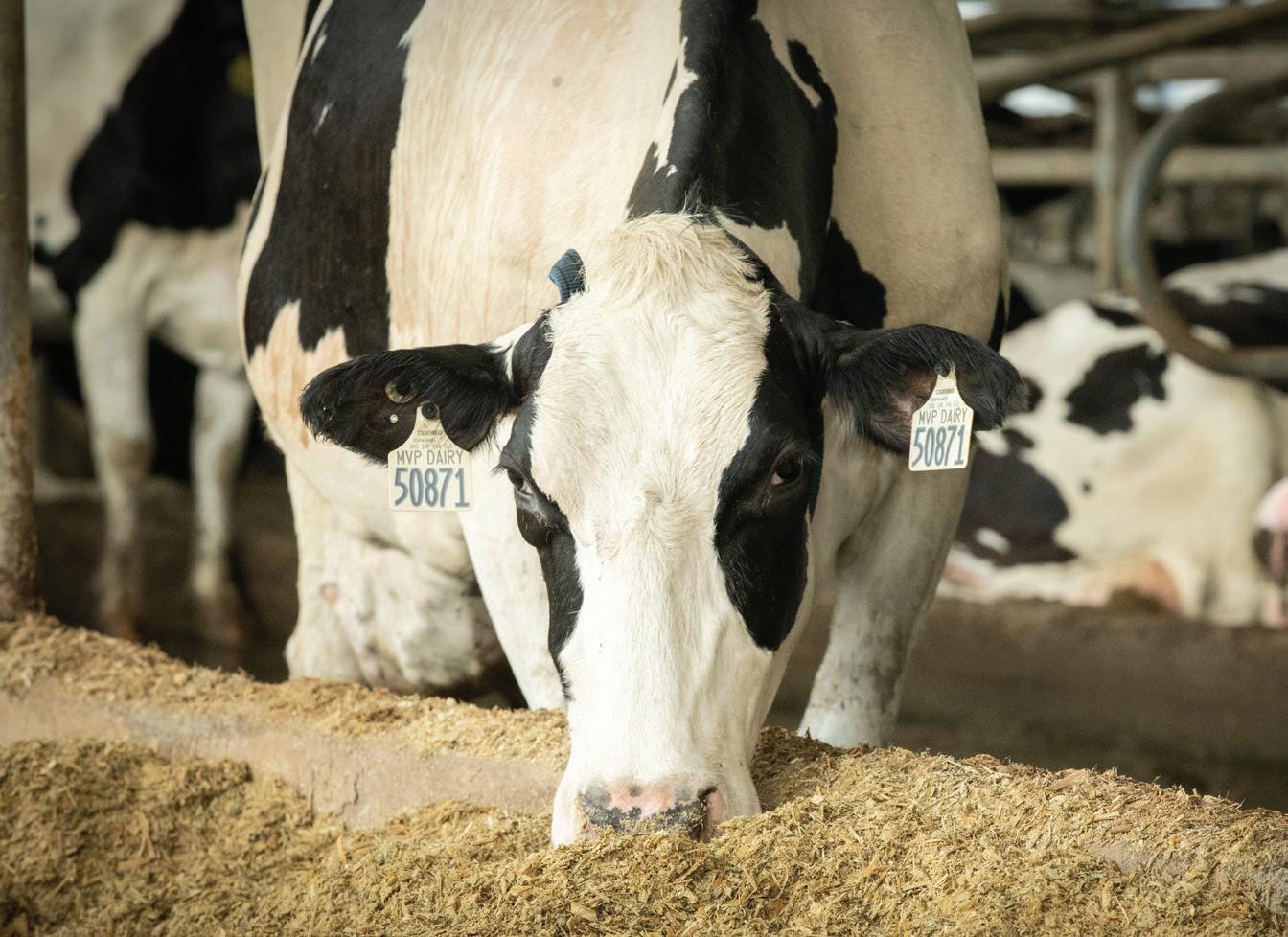
 Kelly Sporer, Ph.D., Records Analysis Consultant, CentralStar Cooperative Inc.
Kelly Sporer, Ph.D., Records Analysis Consultant, CentralStar Cooperative Inc.
To take something “at face value” means that without question you accept it as it appears. Cull rate might be one of those metrics that your farm takes at face value when in reality there are many factors at play. Are you keeping track of involuntary versus voluntary culls? What are the root causes of your involuntary culls? How accurate is your record keeping? Cull rate can be easily swayed by misinformation or misinterpreted information, but it is still a critical metric that feeds into herd profitability and Net Herd Replacement Cost (NHRC).
After evaluating more than 50 herds in Michigan and Indiana who utilize Select Reproductive Solutions® (SRS®) consultative services, the average non-dairy cull rate was 32% with a range of 18-45%. Ideally, cows would leave the herd on the producer’s terms, meaning the cull would be voluntary and wouldn’t be predicated by death or infertility. In a best-case scenario, the majority of cows leaving the herd would be mature cows that have finally dropped below a desired cutoff for milk production following a long, productive and trouble-free life, walking on to a trailer to now provide beef for the consumer. Ramp up record keeping
Knowing the industry benchmarks and outlining our goals are the first few steps of cracking cull rates. Next up is accurate recording of culls. Accurately recording all culls is crucial to truly understand the herd’s challenges and opportunities. The top reason I see for many cows leaving the herd is “low production” and that notation looks like a voluntary cull. However, digging a little deeper often uncovers chronic mastitis, transition events and lameness. I also observe many culls with no remark recorded, or the dreaded term: “unknown.” Unexplained deaths and illnesses warrant further investigation involving the producer’s entire team, from the veterinarian to the nutritionist to the reproduction/ genetic consultants. The top herds in my region maintain a death rate less than or equal to 4% and my experience shows that anything above 6% requires immediate attention.
Consider your culling culprits to enact change
INJURY: One issue that I see leading to involuntary culls, including deaths, is injury. Injuries warrant a total evaluation of facilities and animal handling by all employees. There is nothing worse than a healthy, productive cow’s life cut short by an avoidable injury.
MASTITIS, LOW PRODUCTION AND REPRODUCTIVE CHALLENGES:
Another common culprit of involuntary culling is chronic mastitis. Again, these cows may be recorded as leaving the herd for low production or reproductive reasons, when in reality, a chronic infection reduced her ability to produce milk and become pregnant. Today’s producers have many tools to combat mastitis, including long term solutions such as genetic selection for mastitis resistance and udder conformation.
EXCESS HEIFERS: Too many freshening heifers that force mature, productive cows out of the herd can negatively influence cull rates. Genetic strategies and inventory calculators determine the best heifer inventory for your herd. Michigan and Indiana herds that are producing impressive Energy Corrected Milk (ECM) maintain about 40% third and greater lactation cows in the herd and have excellent nutrition, cow comfort and transition care. These herds recognize that the extra effort in taking care of these mature cows pays for itself and carefully balance their replacement with an optimal proportion of genetically superior heifers.
Optimize your cull rate
Cull rate may seem like a simple metric, but digging deep to understand how your team is defining cull rate and establishing your goals is a critical component of profitability. As you look for ways to troubleshoot your cull rate, consider these top three tips from producers for improving overall herd health and lowering involuntary culls:
1) a monitoring system such as CowManager®
2) regular records analysis with your consultant team to identify and monitor trends and patterns in cows leaving the herd
3) genetic selection using an index such as Herd Health Profit Dollars® (HHP$®) that creates productive, longer-lived cows. u
u 6
COULD THE NET HERD REPLACEMENT COST
METRIC BE A BEACON FOR YOUR HERD?

Calculating NHRC
Emily Middleton-Gyomory, Regional Consulting Manager, CentralStar Cooperative Inc.
It’s not surprising that dairy herd profitability varies from herd to herd, and even within each herd it varies from year to year. However, Net Herd Replacement Cost (NHRC) is a metric that is highly correlated with profitability and is consistently one of the top drivers of dairy herd profitability.
As NHRC decreases,
In a joint study by Zoetis and Compeer Financial, NHRC accounted for a $375 per cow per year difference between the top third most profitable herds and the bottom third least profitable herds. profit increases.
NHRC is calculated by multiplying the number of cows that have left the herd in the past year by the cost of a replacement, subtracting the revenue from cull cows, and dividing the difference by the total hundredweights (cwts) of Energy Corrected milk (ECM) sold in a year. It is essentially the difference between the cost of a replacement heifer and the value of the replaced cull cow.
((# Cows Sold + # Cows Died) × Replacement Cost)) - (# Cows Sold × Cull Cow Value)
(CWTs of ECM Sold) = NHRC
In 2021, Zoetis reported that the top third of the herds for profitability had a $1.01/cwt NHRC and produced 88.2 lbs ECM/cow/day. The bottom third of herds had a $1.88/cwt NHRC and produced 78.4 lbs ECM/cow/day. Herds should strive to lower their NHRC and set their sights on $1.01/cwt.
Tips for achieving your desired NHRC
The key to reducing your NHRC is to reduce the number of cows that involuntarily leave the herd, especially due to death, and to increase ECM. Herds with high cull rates have higher proportions of first and second lactation cows. Second lactation cows produce 15% more milk than first lactation cows, and third lactation cows produce 10% more milk than second lactation cows. Reducing involuntary culling and right-sizing heifer inventory allows for more mature cows to stay in the herd. It is also important to optimize voluntary culling and replace less productive cows with heifers of higher genetic potential.
Take this example of a 1,000-cow herd that currently has a 40% cull rate and 40% first lactation cows. The herd has an 8% death rate and ships 295,802 cwts of ECM per day. Cull cow prices are currently high,
which helps lower NHRC, and their current NHRC is $1.08/cwt. In the proposed scenario, the percentage of cows sold and died is lowered to a combined 30%. Additionally, the percentage of first lactation cows is reduced from 40% to 30% allowing the herd to milk 50 more second and third-plus lactation cows adding an additional 2,934 cwts of ECM shipped. This could potentially lower the herd’s NHRC to $0.83/cwt, which is $72,000 in savings.
Herds with the lowest NHRC have minimized health events, mastitis and death rates; get cows pregnant efficiently; and maintain a high proportion of high-producing mature cows. Utilizing Select Sires’ Herd Health Profit Dollars® (HHP$®) index, genomic testing and a customized inventory strategy can create these high producing cows that will stay in the herd and reduce NHRC.
Hone in on your NHRC by contacting your local Select Sires consultant. Together, analyze your herd’s current metrics and compare them to industry benchmarks to create a plan that drives more profit to your business. u
u 7
# Cows Sold ( ) ) ) + - x x = ( # Cows Died Replacement Cost CWTs of ECM Sold NHRC # Cows Sold Cull Cow Value GOALS FOR YOUR DAIRY: NHRC = $1.01/cwt ECM/cow/day = 88.2 lbs.
NET HERD REPLACEMENT VALUE CALCULATOR CURRENT SCENARIO PROPOSED SCENARIO Number of Fresh Cows 1,000 Number of Fresh Cows 1,000 Cows Sold 320 32% Cows Sold 240 24% Cows Died 80 8% Cows Died 64 6% Replacement Cost $2,000 Replacement Cost $2,000 Cull Cow Value $1.00 Cull Cow Value $1.00 Cull Cow Weight 1,500 Cull Cow Weight 1,500 CWT Milk Sold 295,802 CWT Milk Sold 295,802 Reduced 1st Lact % - Additional Milk CWT 0 Reduced 1st Lact % - Additional Milk CWT 2,934 Cost per CWT Produced $1.08 Cost per CWT Produced $0.83
) (
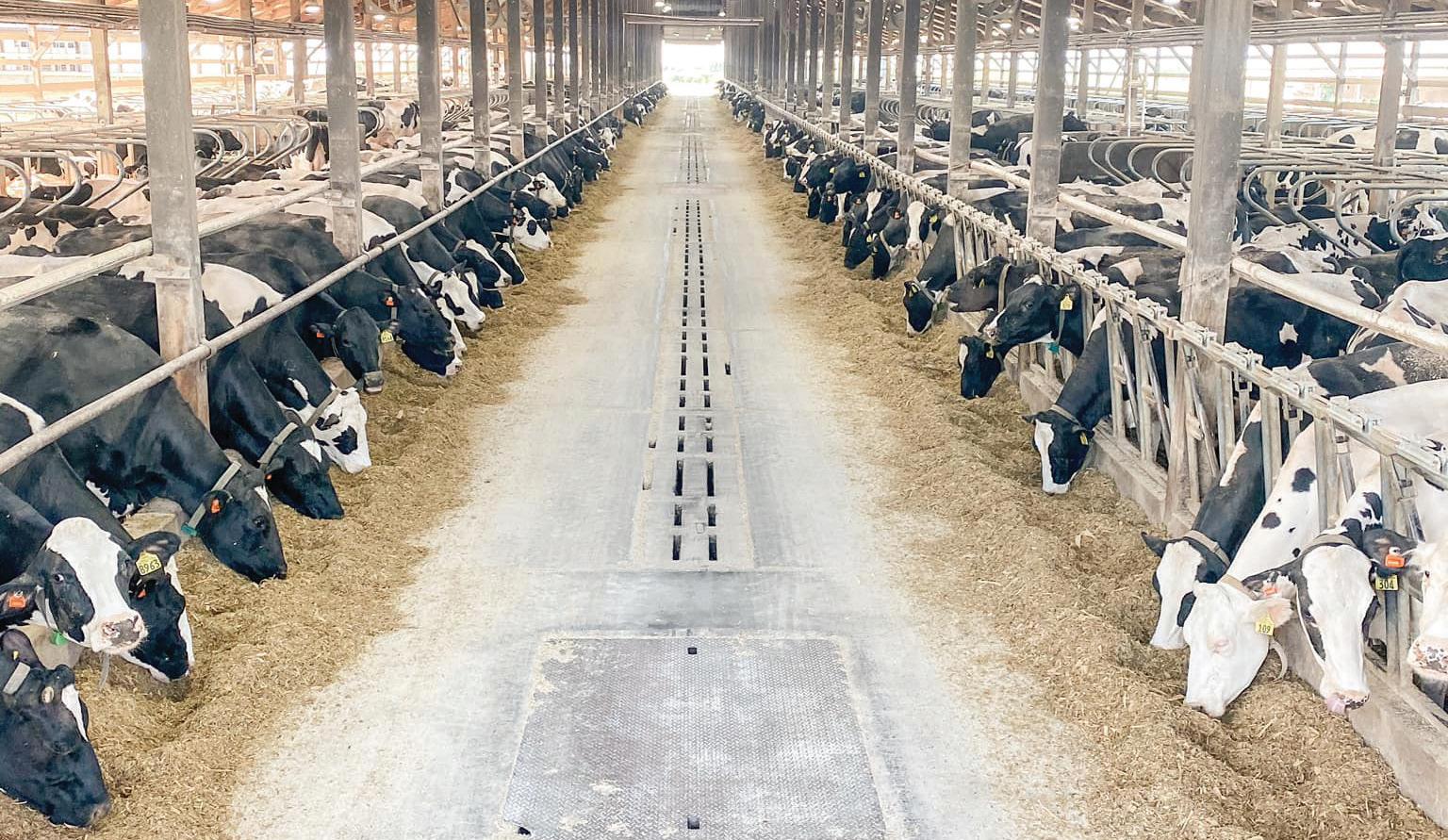
TIME IS MONEY ESPECIALLY IN REPRODUCTIVE MANAGEMENT
There are several metrics producers use to manage and evaluate their operations, and many of them boil down to the simple construct that time is money. Every dairy dedicates a large portion of their day and resources to reproductive measures - getting heifers and cows pregnant. Time is spent on labor and there are costs associated with days open, the number of times cows are bred before they are confirmed pregnant, the time cows are lactating before first service and more. By improving these reproductive metrics and achieving labor efficiencies, the bottom line has improved at Foresight Farms, Decorah, Iowa.
Foresight Farms is a partnership between Dave and Jean Wise, their son, Jared, and son and daughter-in-law, Ethan and Allie. Farming over 2,800 acres of crop land, the dairy milks just over 1,000 cows. High genetic potential animals are identified using genomic testing and serviced exclusively with sexed semen, with the balance of the herd bred to beef sires.
Seven years ago, Dave and his team made two important management decisions that accelerated the genetic and reproductive advancement of their herd. First, they transitioned the herd from the aAa mating system to Select Mating Service® (SMS®). Second, they leaned on a team of Select Sires consultants to analyze the herd’s reproductive data and create plans for improvement.
Sire selection and genetic advancement
To drive genetic progress, the team relied on Select Sires Member Cooperative Genetic Consultant, Lars Sivesind, to evaluate the herd and create the most profitable matings using Select Sires genetics. “We realized that compared to our peers, the genetic capability of the herd was not up to par. I’m not the type of guy that is comfortable picking bulls, so I was looking for a team that not only helped with selecting sires but would lead us in a solid direction for a commercial herd,” says Dave.

u 8
L-R: Allie and Ethan Wise, Jean and Dave Wise and Jared Wise
Foresight Farms’ genetic focus targets health and wellness. Sires are selected for Dairy Wellness Profit Index® (DWP$®) and Herd Health Profit Dollars® (HHP$®). “Healthy cows are happy cows, and happy cows make milk,” says Dave. “If you don’t have a healthy cow, she’s not going to be around very long. The cost of raising heifers is expensive, and if we can keep a productive cow in the herd a little longer, that’s nothing but a positive for us. Good feet and legs and the basics are important, but the health traits and fertility are going to be the next frontier for picking the next generation of our genetics.”
Because HHP$ is 45% Combined Fat and Protein (CFP) Foresight is protecting components too. In fact, since 2019 their Energy Corrected Milk (ECM) went from 93.8 pounds to 108.1 pounds.
Reproductive efficiencies
“When we were making the decision to rely on one genetic supplier, working closely with a consultant and having them be a part of our team was very important to us,” says Dave. “Working with one company that has a one-stop shopping center made sense. We could get it all under one roof with Select Sires.”
In tandem with the mating philosophy changes, the team decided to install the CowManager® monitoring system to assist with reproduction and animal health. Since the beginning, Ted Patterson, CowManager specialist, Select Sires Member Cooperative, has been instrumental in teaching the farm’s team how to use the system and answer any questions. “My herdsman, Ben Guevara, has been with me for 17 years. He would never let me get rid of CowManager now,” says Dave. “It’s like having another person watching the cows. It has helped us narrow down the times we breed, especially in our heifers, which are housed at a different facility. It’s helped us nail down the right time to get semen in a cow.”
The metrics don’t lie. In the seven years Foresight Farms has had CowManager they have seen their days open fall from 120 to 101 days. At the recommendation of Select Sires Member Cooperative Reproductive Consultant, Jake Kempel, the farm began utilizing a double ovsync program for first service breedings five years ago. This resulted in conception rates increasing from just below 40% to consistently over 50%. Pregnancy rates were just above 20% and they are now regularly above 30%.
Since January of this year, 25% of the farm’s total services have been the result of natural heats, with a 45% conception rate. Over the same time period, second lactation or greater animals have a 50% conception rate at first service.
With the average cost of one day open between $2 and $6, the farm is seeing a significant impact on their bottom line. Dave and his team have truly used CowManager to ensure they are getting cows and heifers bred at the right time to boost conception.
Growth and expansion are on the horizon for Foresight Farms. With the recent acquisition of a second all-robotic dairy, Dave intends to keep leaning on the teams at Select Sires and CowManager to help the farm continue to improve
and focus
the
to
“I started milking cows in a 40-cow
by
and I’ve realized when you
in numbers, you can’t do it all by yourself. It makes those you work with
and we’ve
u 9
Foresight Farms’ current herd status from benchmarks off MILC, February 14, 2024
efficiencies
on
metrics important
his bottom line.
so important,
been able to surround ourselves with a really great team who is focused on improving our herd and making it better.” u Key Performance Indicators (KPIs) Current Goal 21 Day Preg Risk 31 32 Service Rate 69 60 Conception Rate 44 40 1st Lactation Conception Rate 47 43 2nd Lactation Conception Rate 44 40 ≥3rd Lactation Conception Rate 42 38 1st Breeding Conception Rate 49 45 2nd Breeding Conception Rate 39 40 ≥3rd Breeding Conception Rate 40 36 Average Days in Milk at First Breeding 73Percent Bred <75 Days in Milk (all cows) 84Percent Bred <75 Days in Milk (monthly) 0Days Open 103 110 Percent + Preg Diagnosis 62 52 Percent + Conf Diagnosis 97Number of Do Not Breed Events 131Number of Fresh Events 1,227Heifer 21 Day Preg Risk 43 30 Heifer Service Rate 67 55 Heifer Conception Rate 60 50 Average Days Old at First Breeding 405 405 Average Days Old to Conception 417 420 Do Not Breed Inventory 72PTA or BV Date of Birth 2016 2017 2018 2019 2020 2021 2022 2023 2024 211 353 529 530 621 770 853 912 1,038 200 0 600 400 1000 800 1200 All Sires HHP$ Linear (All Sires HHP$) Genetic Trait Selection Profile: Foresight Farms
barn
myself,
start to grow
THERE’S A NEW STANDARD FOR PASSIVE IMMUNITY
FIRST DAY FORMULA CR: ESTABLISHED AS A COLOSTRUM REPLACEMENT, EMERGING AS A MATERNAL COLOSTRUM SUPPLEMENT
 David L. Cook, Ph.D., Technical Services Manager, Milk Products
David L. Cook, Ph.D., Technical Services Manager, Milk Products
Top priority with newborn calves has always been high-quality colostrum to achieve successful transfer of passive immunity. The long-standing definition of successful transfer has been 10 grams of IgG per liter of serum within 24-36 hours after feeding colostrum. A research study on a large southwest dairy1 demonstrated that 299 of the 300 calves fed a full dose of First Day Formula® CR achieved successful transfer of passive immunity, equivalent to the other calves in the study that were fed excellent quality maternal colostrum. The efficacy of First Day Formula is obvious – it has been established as an excellent colostrum replacement. However, could there be benefits to using it as a supplement?
Reviewing new research data2
A recent publication citing transfer of passive immunity data of 2,360 calves from 103 operations2 combined with subsequent morbidity and mortality3 demonstrated that calves achieving higher levels of IgG transfer, exhibited lower mortality and significantly less episodes of illness.
The publication concluded that there are substantial benefits, especially health related benefits, of achieving higher levels of transfer of passive immunity. This recent research validates 25 grams IgG/liter of serum compared to the previous standard of 10 IgG/liter. This boost in IgGs has been linked to improved lifetime calf health and is being referred to as the new “excellent” transfer of passive immunity goal. With this information in mind, Select Sires Inc. has established new recommendations for colostrum management.
u 10
Data collected from USDA’s NAHMS Dairy Studies
REFERENCES: 1Lago, 2019; 2NAMHS Data; 3Lombard, et.al, 2019; 4NAHMS, Wells, 1996; 5Fowler, 1999; Faber et al., 2005; Nocek et al., 1984; Robison et al., 1988; Faber, 2005; 6Faber et al., 2005; 7DeNise, 1989; Faber, 2005; 8Progressive Dairyman 29 June 2018.; 9Lopez et al., 2020 100 90 80 70 60 50 % of calves remaining healthy 0 10 20 30 40 50 60 Days of Age Excellent Good Poor Fair Serum IgG cut-points (g/L) 0 5 10 15 20 25 30 Previous Standard Select Sires Standard Fail Discard or use as transitional milk Feed Supplement Pass
Farmgirl Photography Photo

Replace,
Supplement or Feed
Step 1: Test maternal colostrum with a Brix Refractometer (*For Jersey calves, deduct 2 from Brix values)
• <20* – Discard or use as transitional milk
• Replace with one full dose (500 grams/150 IgG) of First Day Formula CR or First Day Formula CR Deluxe
• 20-24* – Supplement maternal colostrum with First Day Formula CR
• 50 grams of IgG is equivalent to 166 grams of First Day Formula CR
• 166 grams is equal to one third of a 500 gram packet or one scoop of the provided scoop in the 20 lb. pail
• ≥25* – Feed 3-4 liters
Step 2: Retest the colostrum
• Use a Brix refractometer to measure the Brix percentage to ensure excellent quality is met
Step 3: Feed the calf
For dairies raising their own replacement heifers, achieving the newly established “excellent” level of transfer of passive immunity translates to well-documented lifetime benefits, including:
• reduced treatment and mortality rates,4
• improved growth rates and feed efficiency,5
• decreased age at first calving6 and
• increased first and second lactation milk production.7
Beef on dairy calves can also benefit from excellent transfer of passive immunity, including those being born on the dairy and transported to calf grower facilities. These calves are often faced with considerable challenges early in life such as transportation and comingling. Research8 shows there is significant risk for calves that fail to receive adequate transfer, including:
• 6.4 times greater risk of being sick during the first 28 days of life,
• 3.2 times greater risk of being sick any time prior to weaning,
• 5.4 times greater risk of death prior to weaning,
• sickness during the first 28 days of life that was associated with a 35-pound lower expected weaning weight, and
• greater risk for feedlot respiratory morbidity.
This research indicates that achieving excellent transfer of passive immunity will result in fewer calves getting sick
throughout the production cycle. This means that healthy calves entering the feedyard will have better feed conversion and increased average daily gains compared to those treated for calfhood sickness.
Recommendations for excellent transfer of passive immunity
Calf growers in various parts of the country have found that excellent transfer of passive immunity can be achieved consistently and economically by supplementing maternal colostrum with First Day Formula CR. These calf growers follow specific protocols of testing maternal colostrum and supplementing.
A controlled research study completed at Penn State University9 with 80 newborn Holstein calves demonstrated that First Day Formula CR, which is manufactured with a whey-based colostrum ingredient, is a viable supplement to be added directly to average IgG level maternal colostrum to achieve excellent transfer of passive immunity. The increase can be attributed to the whey-based colostrum ingredient having a higher concentration of IgG and more soluble than whole colostrum-based ingredients. The combination of wheybased colostrum replacer and maternal colostrum achieved the highest level of IgG absorption in the study.
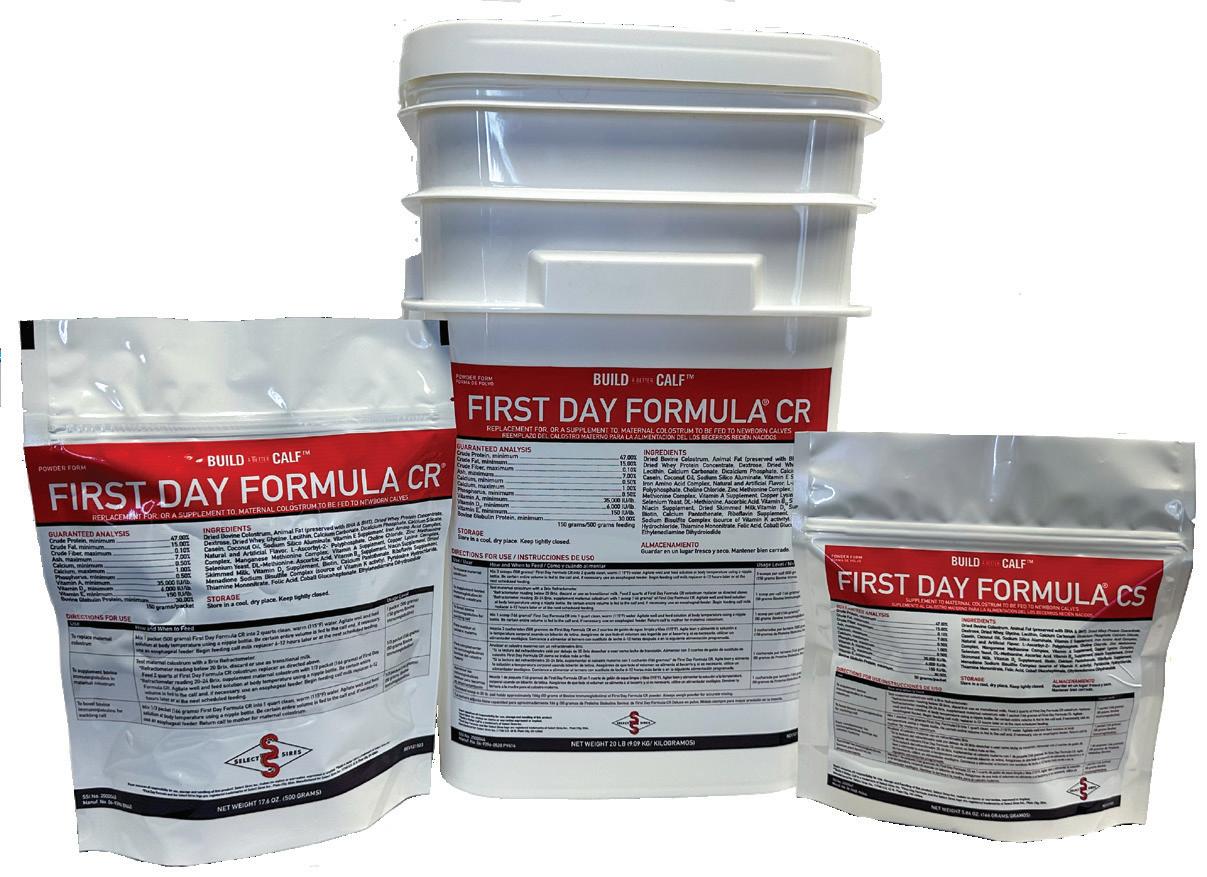
Select Sires protocol for maternal colostrum supplementation with First Day Formula CR, makes achieving excellent transfer of passive immunity – not only possible, but easy and affordable. u
u 11
Brix % Colostrum IgG 16.0 28.8 17.0 34.4 18.0 40.1 19.0 45.8 20.0 51.4 21.0 57.1 22.0 62.8 23.0 68.4 24.0 74.1 25.0 79.8 27.0 91.1 28.0 96.8 29.0 102.4
THE SUPPLY CHAIN’S WISH LIST
ProfitSOURCE® is designed to help you produce high-quality, uniform, desirable cattle. Following are a few tips to help you strengthen partner relationships and elevate your return.
GROWERS
PROGRAM INFLUENCE
HEALTH
Adhering to ProfitSOURCE’s calf care best practices can help set you up for success!
VOLUME
Think consistent whole groups of program cattle that are trouble-free, efficient and high performing. The ProfitSOURCE kind!
Enroll in the ProfitSOURCE program and tag those high-value calves for easy identification!
UNIFORMITY
The ProfitSOURCE sire lineup has some of the most targeted EPDs in the industry, with little spread among minimums and maximums for each trait.
FEEDERS
EFFICIENCY
Creating a higher-value animal that exhibits feed and growth efficiency is of great value to feedlots, and is the mission of ProfitSOURCE.
PACKERS AND RETAILERS
POUNDS AND YIELD
More meat means more dollars. ProfitSOURCE sires are selected to produce high-quality, uniform, desirable cattle!
QUALITY
Traceability-fueled insights show our Angus x Holstein enrolled program cattle are grading 95% Choice and Prime, which are the highest two USDA Quality Grades.

UNIFORMITY
ProfitSOURCE genetics are creating uniform cattle, which have been described as “peas in a pod.”
UNIFORMITY
The beef on dairy story is starting to transcend beyond just the dairy, and ProfitSOURCE is being requested from packers by name.
 DON GALES Chairman & CEO Friona Industries
DON GALES Chairman & CEO Friona Industries
We, as an industry, are going to have to be more comfortable on transparency and consistency. Beef on dairy genetics to me does both of those. If we get the genetics right, what we’ve seen is that we can get better genetic profile animals when we look at feedability, ribeye area, which is huge, and overall cutability.
As a risk management tool, position your beef on dairy cattle as elite with the help of ProfitSOURCE genetics, proper calf care and calf health records. And be sure to tag your calves with the appropriate program tags as ProfitSOURCE’s visibility continues to grow. Ask your Select Sires representative how to enroll today! u

Scan the QR code to learn more about the supply chain’s wish list.
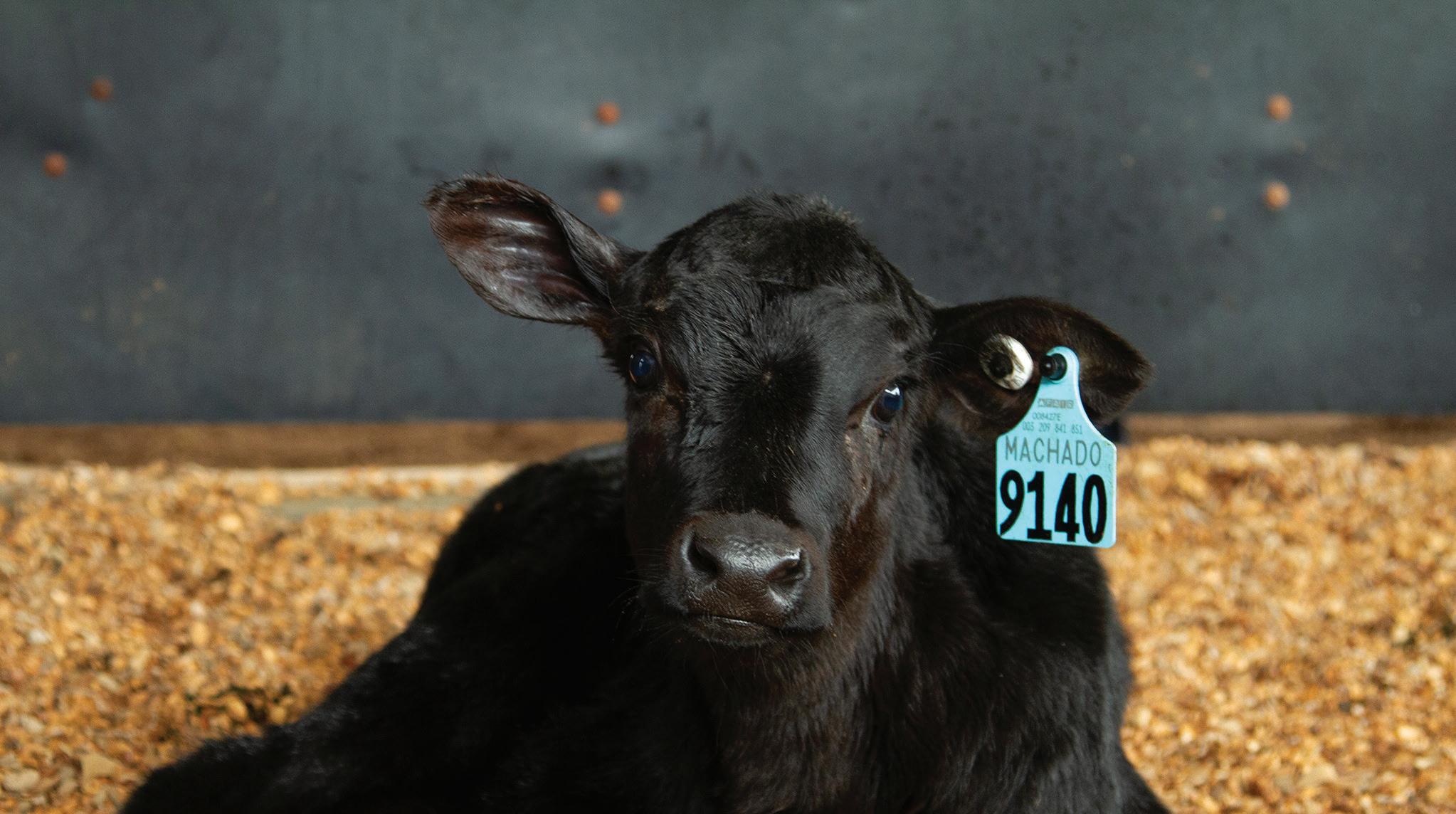
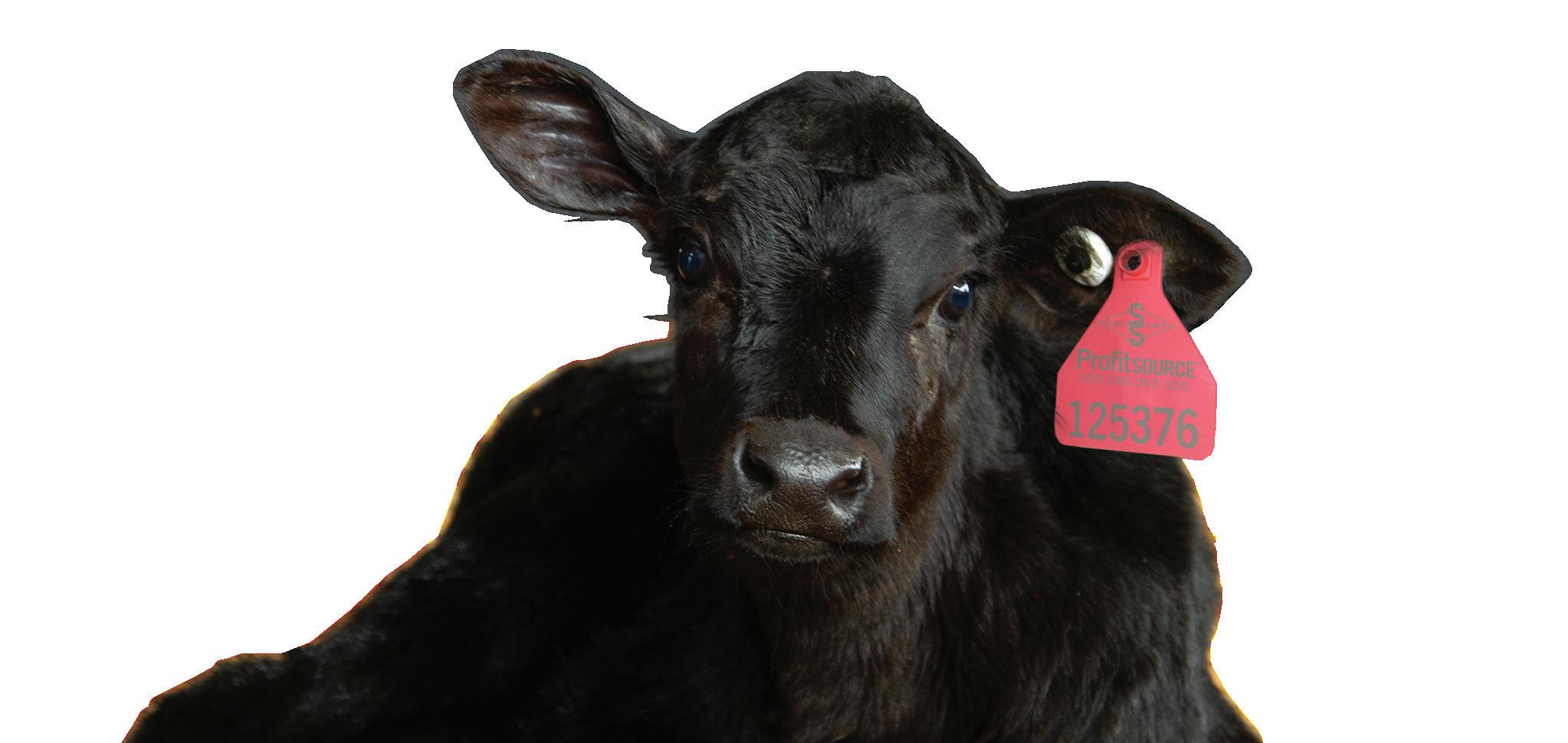
u 12
LISTEN CAREFULLY YOUR HOSPITAL PEN IS TALKING

 Jordan Siemers, Sire Analyst, Select Sires Inc. Genetics Manager, Siemers Holsteins
Jordan Siemers, Sire Analyst, Select Sires Inc. Genetics Manager, Siemers Holsteins
Having good records is paramount for sound decision making. Record every health event and every treatment because accurate records will reveal patterns and opportunities. Understanding your herd health landscape will help fine-tune management decisions and provide valuable insights for sire selection. Events like mastitis and lameness aren’t solely dependent on management, the genetic component is strong and will reveal itself if record keeping remains a priority. The hospital pen is not something many farmers like to dwell on – it’s a money pit of treatment costs and lost production. Farmers often want to get it off their minds as quickly as they want to graduate cows back into general population. Pause to review the metrics generated from the cows in the hospital pen – they have a lot to say. Invite genomics to join the conversation and your hospital pen will begin to disclose critical trends in lameness and mastitis scores. Below are some unique ways that I mine and analyze data from the hospital pen. I’ll also share some practical ways in which I use this data to make management decisions.
Metric No. 1: Percent of cows in the hospital with mastitis.
Follow up questions:
Are these cows coming from a certain pen or from a certain facility?
Can we use previous somatic cell count (PSCC) and SCC as indicators of who might be susceptible to a mastitis event?

Metric No. 2: Percent of cows in the hospital that are lame.
Follow up questions:

Where is the lameness occurring?
Can we change facilities to lessen lameness events?
Is the concrete acceptable?
Metric No. 4: Number of sick cows identified per milking shift.
Identify which milking shift is assigning the most cows to the hospital pen. This metric might seem to carry a negative connotation, but it’s an opportunity for these “finders” to teach other team members how to identify sick cows earlier and why early prevention is important for cow recovery and your bottom line.
Metric No. 5: Breakdown of hospital pen cows by stage of lactation and lactation number.
Follow up questions:
Are there commonalities in the stage of lactation or lactation number of the cows that find themselves in the hospital pen?

Do we need grooving or even one step more - rubber?
Did we get a batch of bad sand that we need to run through a gravel screen to remove pea gravel stones?

Are we treating more older cows in the hospital pen?
Should these frequent flyers be gestating our next generation of replacement heifers or carrying a terminal beef on dairy calf?

Metric No. 3: Days in the hospital for individual cows. The days can blend together, it’s important to date every pen move so you know if a cow has overstayed her welcome in the hospital pen.

Metric No. 6: Hospital trips in her lifetime.
For this final metric, you must have exceptional records! If she has had a hospital pen stay LACT 1, LACT 2 and is now in the hospital in LACT 3 – this cow should be on the do not breed (DNB) list.
As you see in these examples, the milking parlor is where most health concerns are identified. Genetic selection for generational improvement of health and wellness is our goal. In the meantime, how will you limit and prevent the impact of health events during the dry period? Turn the page to learn how CowManager® transition alerts can help during this important and often overlooked time in a cow’s life. u


u 13
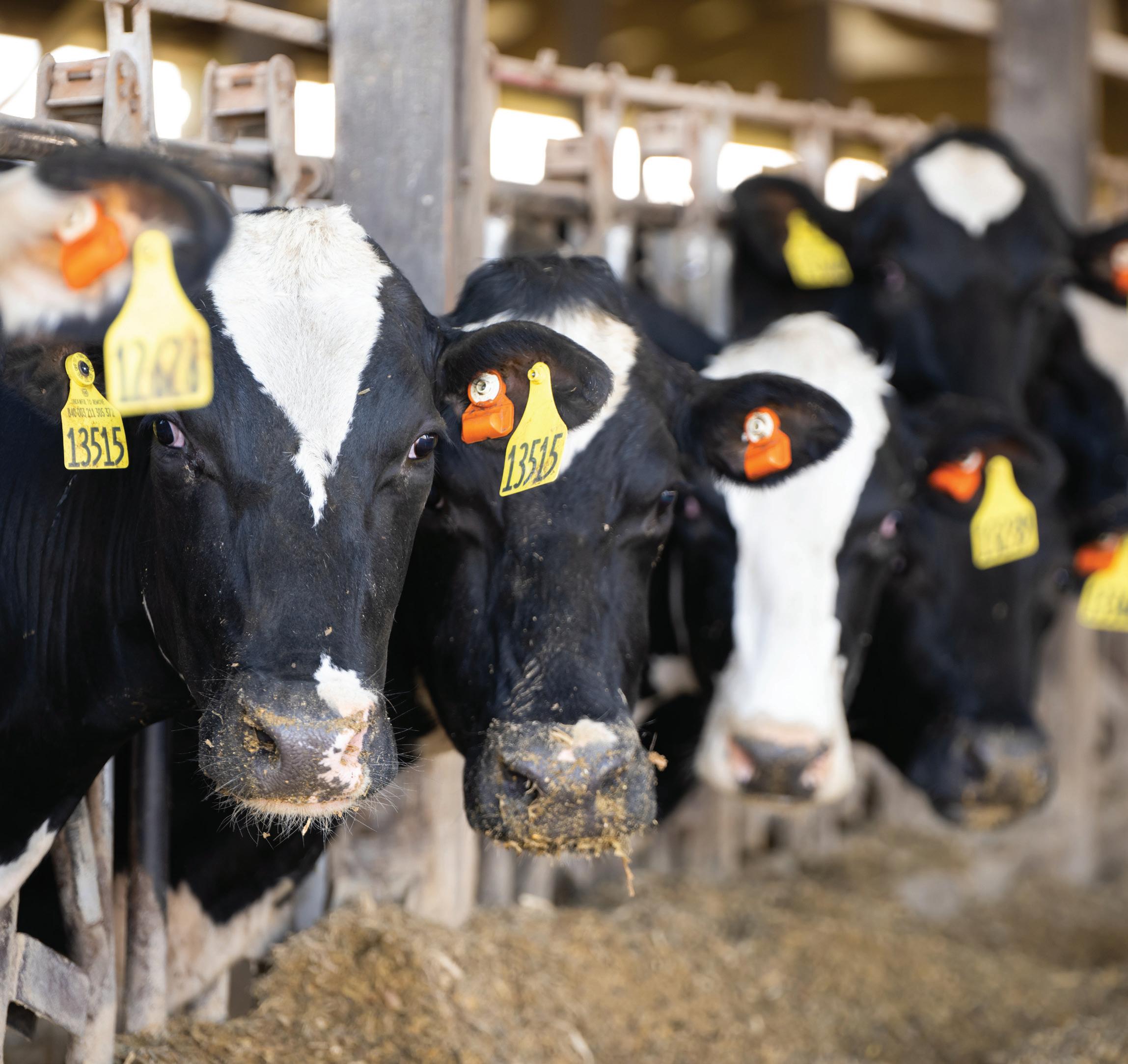
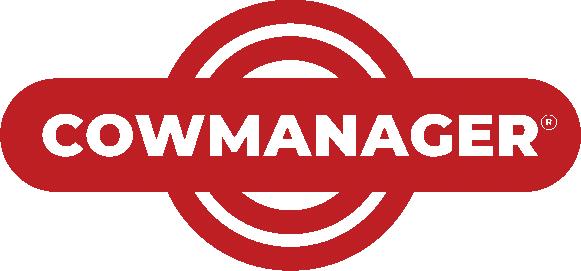
HOW TO PREDICT HERD RISKS WHEN NEEDED MOST:
THE TRANSITION PERIOD
A cow’s transition period can be a make-or-break moment in her life, with nearly 80% of health events occurring during the transition period. Extra stress on a cow during her dry period can be detrimental to both her health and that of her calf, creating the potential for multigenerational impact.
But how can you predict these risks during the transition period? Transition cows are often not as closely monitored as the cows moving through the parlor or being monitored for heats. Labor continues to be a challenge and years of training and cowside experience are required for early detection of at-risk cows. Here’s a simple three step breakdown to showcase CowManager’s innate ability to help your team members predict, prevent and resolve health risks surrounding the transition period.
u 14
The subtle symptoms and responses to transition period stressors can be identified using CowManager’s nutrition module. Transition alerts can pinpoint at-risk cows by identifying underperformers during the dry period and alerting producers to animals that are candidates for postpartum health issues.
“Cows are reported showing abnormalities in their behavior and feed intake 50 days prior to their due date,” says CowManager Product
Manager Peter Hut, DVM. “These cows have a higher risk of becoming sick after calving, with greater than 85% of them becoming exceptionally ill within 30 days after calving.” Early identification of these animals offers farmers more opportunities to leverage preventative therapies and avoid serious health events from impacting herd health, production and ultimately, profitability.
Interventions
It is important to understand that the at-risk alert is not an indicator of an actively sick animal. Rather, in the true sense of the term, it is an alert to the potential of trouble down the road. Comparing eating and rumination time of herd mates offers valuable insights. These comparisons can lead farmers to the cows that might require extra monitoring or that should be on a watch list for postpartum health issues.
You may think you need to do something today with an alert. With transition alerts this is not always the case. Transition alerts aren’t “act now” alerts, but instead should be interpreted as “underperforming, keep an eye on her” alerts. This gives you a predictive preview of which cows may get sick after calving.
Use Data to Identify At-Risk Cows
Without the use of technology, identifying a cow that is at risk of a health event is a very time-consuming task. Early identification of cows at risk can save producers time and money. Data identifies symptoms not easily recognizable by a passing human eye.
Often, health problems in fresh cows are the result of compounding, underlying issues that have gone unnoticed over time. Classic sickcow identifiers, such as lack of activity or reduced feed intake are easily observable, but understanding why she has gone off feed is critical.
All eyes on the road to recovery
You could compare the at-risk alerts to the adage “an ounce of prevention is worth a pound of cure.” CowManager is designed to be an extra set of eyes in the herd to deliver valuable data and insights to help farmers make the best decisions for cow health and financial wellbeing. From the moment a cow is identified with her first transition alert, she remains at-risk until after calving. At-risk cows are easily tracked and their treatments can be reviewed; no more monitoring based on lucky guesses and hunches. Farmers can rely on the precise data provided by the nutrition module to know exactly which cow warrants extra attention during the crucial transition period – creating labor efficiencies while improving herd health. u
Cows that eat less before calving and become sick after calving likely had an inflammatory response prior to going into labor. Dr. Hut summarizes three potential reasons for this type of response pattern: inflammation, pain and stress. For each of these reasons, he links possible culprits such as mastitis in the case of inflammation, lameness that causes excess pain and chronic stress from heat or other management factors.
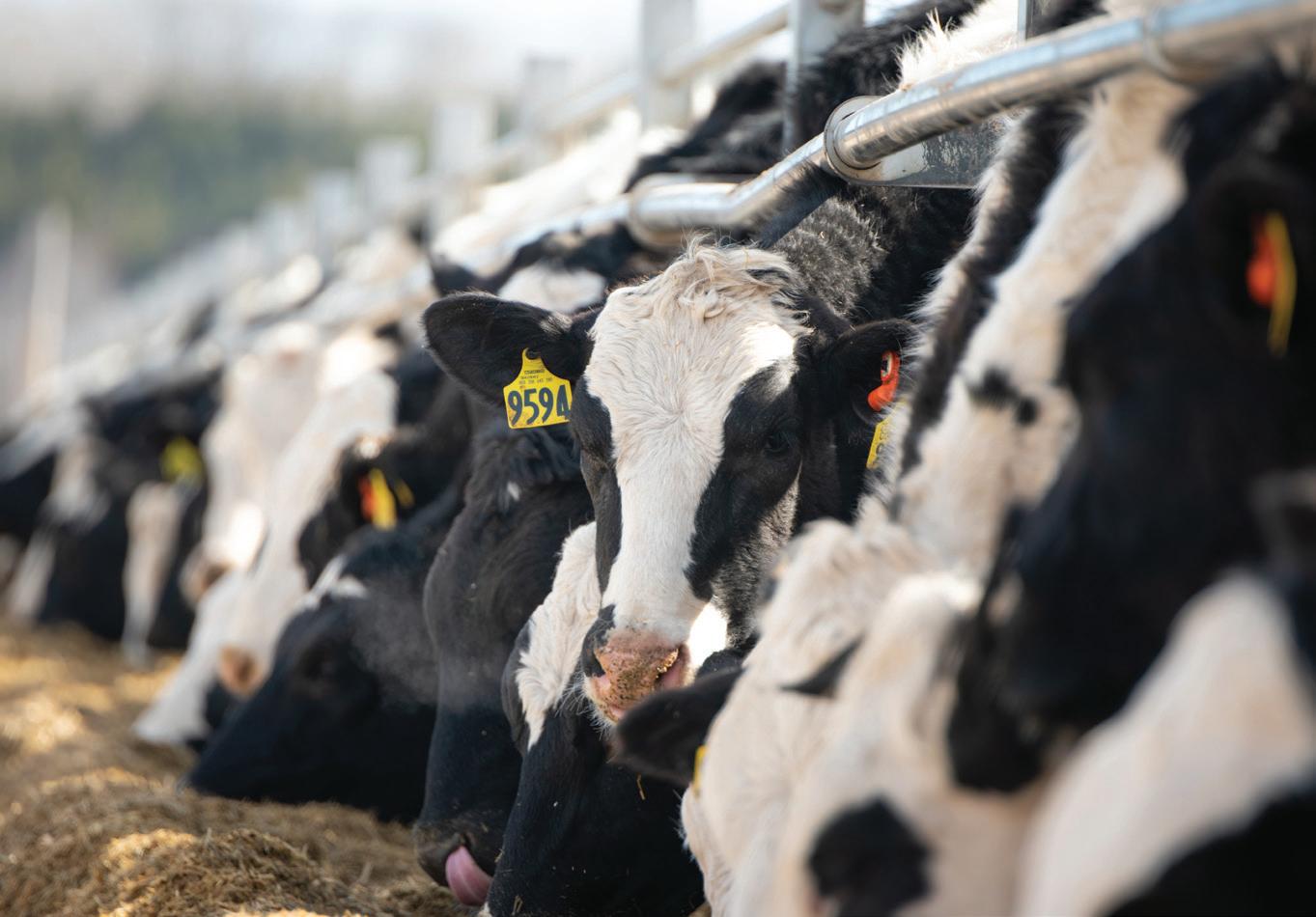
u 15
1 2 3
Pinpoint At-Risk
Leverage the Nutrition Module to
Cows Before Calving Establish Proper Protocols with Preventive
S ELECTIONS
OUR MISSION
With the highest integrity, maximize the productivity, profitability, and sustainability of livestock producers who feed the world.
For more information, visit www.selectsires.com or call (614) 873-4683. Product of the USA.
®NxGEN, First Day Formula, the Select Sires logo, Select Reproductive Solutions, SRS, Select Mating Service, SMS, Herd Health Profit Dollars, HHP$, ProfitSOURCE, and Your Success Our Passion. are registered trademarks of Select Sires Inc., Plain City, Ohio. Buyer assumes all responsibility for use, storage and handling of this product. Select Sires Inc., makes no claims or warranties, expressed or implied. Manufactured for Select Sires Inc., 11740 U.S. 42 N, Plain City, OH 43064.
Dairy Wellness Profit Index, DWP$ and CLARIFIDE are registered trademarks of Zoetis Inc., its affiliates and/or its licensors. CowManager is a registered trademark of Agis Automatisering. Total Performance Index (TPI) is a registered trademark of Holstein Association USA. 04/24 CDCB/HAUSA Genomic Evaluations. All bulls listed in this issue qualify for semen export to Canada. Photo support by Farmgirl Photography and Herdmark Media.
7 = Select Sires, 14 = Accelerated Genetics, 250 = GenerVations
REACH YOUR HERD GOALS WITH TRUSTED ADVISORS
Surround yourself with a team of skilled consultants to identify goals, choose the right programs to evaluate your herd, and provide you with up-to-date information and insights into your breeding strategy.
Select Reproductive Solutions® (SRS®) will provide the support, tools and expertise necessary to improve your herd’s reproductive health.
For 50 years, Select Mating Service® (SMS®) consultants have used research, computerized analysis and cow knowledge to build better herds throughout the world, one mating at a time.
“My favorite part of SMS work is seeing the pride and excitement on my customers’ faces when we reach their goals, and then hearing how eager they are to keep progressing and moving forward. Each day, I work with dairy farmers to help them achieve their genetic goals. We discuss sire selection, sexed and beef semen mating strategies and how we can accelerate genetic advancement in their herd.”
Carly Meyer, Dairy Program Specialist, Select Sires Member Cooperative
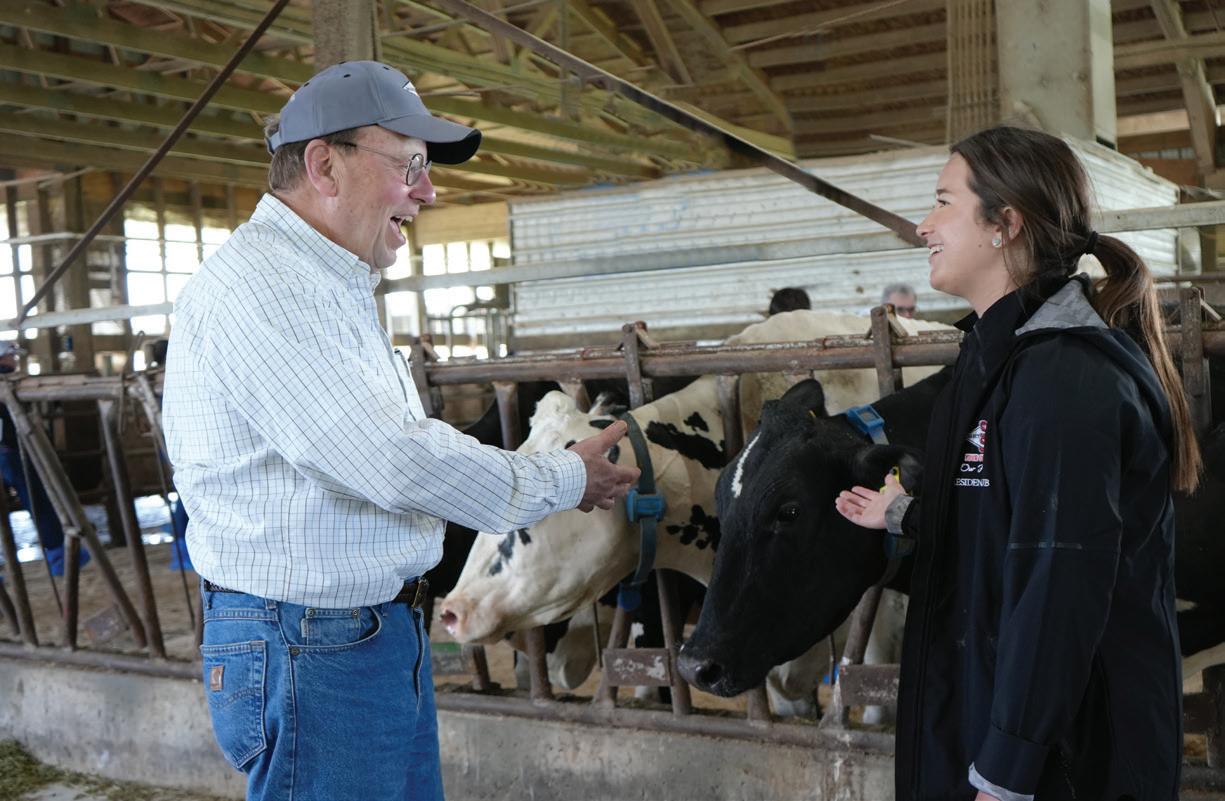
“SMS has allowed the average dairy producer to utilize better genetics more wisely. The program has helped create a better set of genetics for the entire industry and the best set of bovine genetics we’ve ever experienced in the world.”
Jerry Emerich, Dairy Coordinator, Premier Select Sires
PRSRT STD U.S. POSTAGE PAID Minster, Ohio 45865 Permit No. 2
11740 US 42 NORTH • PLAIN CITY • OHIO • 43064-0143

 David C. Thorbahn, President and C.E.O., Select Sires Inc.
David C. Thorbahn, President and C.E.O., Select Sires Inc.






 Kelly Sporer, Ph.D., Records Analysis Consultant, CentralStar Cooperative Inc.
Kelly Sporer, Ph.D., Records Analysis Consultant, CentralStar Cooperative Inc.



 David L. Cook, Ph.D., Technical Services Manager, Milk Products
David L. Cook, Ph.D., Technical Services Manager, Milk Products



 DON GALES Chairman & CEO Friona Industries
DON GALES Chairman & CEO Friona Industries




 Jordan Siemers, Sire Analyst, Select Sires Inc. Genetics Manager, Siemers Holsteins
Jordan Siemers, Sire Analyst, Select Sires Inc. Genetics Manager, Siemers Holsteins











